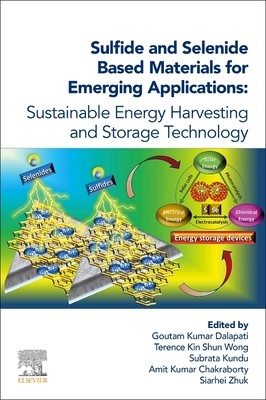
- We will send in 10–14 business days.
- Publisher: Elsevier
- ISBN-10: 0323998607
- ISBN-13: 9780323998604
- Format: 15.2 x 22.9 x 4.1 cm, softcover
- Language: English
- SAVE -10% with code: EXTRA
Sulfide and Selenide Based Materials for Emerging Applications (e-book) (used book) | bookbook.eu
Reviews
Description
Sulfide and Selenide-Based Materials for Emerging Applications explores a materials and device-based approach to the transition to low-cost sustainable thin film photovoltaic devices and energy storage systems.
Part 1 examines recent advances in renewable technologies and materials for sustainable development, as well as photovoltaic energy storage devices. Part 2 discusses thin film solar cells with earth abundant materials, highlighting the power conversion efficiency of the kesterite-based solar cells. Kesterite film technology including different synthesis and doping method designs are also discussed, along with emerging sulfide semiconductors with potential in thin film photovoltaics/flexible devices. In Part 3 sulfur- and selenides-based materials for thermoelectric applications are explored. Part 4 covers chalcogenide semiconductors with applications in electrochemical water splitting for green hydrogen generation and oxygen generation, as well as the latest research on layered 2D transition metal chalcogenides for electrochemical water splitting. To conclude, part 5 discusses recent developments of storage technologies such as Li-S batteries, sulfide-based supercapacitors and metal-ion batteries, and the development of 3D printing sulfides/selenides for energy conversion and storage.
This book is a useful resource for those involved in green energy technology and decarbonization and is designed for a broad audience, from students to experienced scientists.
EXTRA 10 % discount with code: EXTRA
The promotion ends in 16d.13:09:02
The discount code is valid when purchasing from 10 €. Discounts do not stack.
- Publisher: Elsevier
- ISBN-10: 0323998607
- ISBN-13: 9780323998604
- Format: 15.2 x 22.9 x 4.1 cm, softcover
- Language: English English
Sulfide and Selenide-Based Materials for Emerging Applications explores a materials and device-based approach to the transition to low-cost sustainable thin film photovoltaic devices and energy storage systems.
Part 1 examines recent advances in renewable technologies and materials for sustainable development, as well as photovoltaic energy storage devices. Part 2 discusses thin film solar cells with earth abundant materials, highlighting the power conversion efficiency of the kesterite-based solar cells. Kesterite film technology including different synthesis and doping method designs are also discussed, along with emerging sulfide semiconductors with potential in thin film photovoltaics/flexible devices. In Part 3 sulfur- and selenides-based materials for thermoelectric applications are explored. Part 4 covers chalcogenide semiconductors with applications in electrochemical water splitting for green hydrogen generation and oxygen generation, as well as the latest research on layered 2D transition metal chalcogenides for electrochemical water splitting. To conclude, part 5 discusses recent developments of storage technologies such as Li-S batteries, sulfide-based supercapacitors and metal-ion batteries, and the development of 3D printing sulfides/selenides for energy conversion and storage.
This book is a useful resource for those involved in green energy technology and decarbonization and is designed for a broad audience, from students to experienced scientists.


Reviews